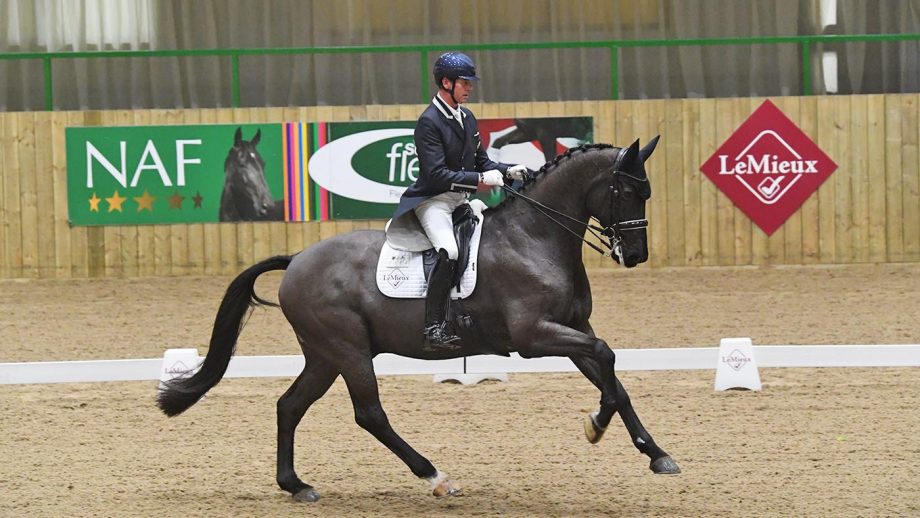Does dressage have a perception issue? Alice Collins investigates whether, and why, the sport is so often misunderstood
TYPE “dressage” into Google and the top two questions that pop up are “What is the point of dressage?” and “Is dressage cruel to the horse?”. Google suggestions reveal what users are searching for, so does the sport have a perception issue?
One of dressage’s enduring problems is that the better it is done, the easier it looks. Not only is it less digestible than its sister Olympic disciplines of showjumping and eventing, but watching the best dressage horses in the world, it would be easy to assume – mistakenly – that dressage is plain easy.
Anyone who’s ever ridden knows that isn’t true. Maybe bridging the gap between reality and perception is all that’s required to drive engagement and popularity.
{"content":"PHA+RHJlc3NhZ2UgcmlkZXIgPGEgaHJlZj0iL3RhZy9yaWNoYXJkLWRhdmlzb24iPlJpY2hhcmQgRGF2aXNvbjwvYT4gaGFzIGxvbmcgYmVlbiBhIGxvdWQgYWR2b2NhdGUgZm9yIHRoZSBzcG9ydCwgYW5kIGEgcmVjZW50IGluY2lkZW50IHdoaWxlIGZpbG1pbmcgYXQgaG9tZSBwZXJmZWN0bHkgZW5jYXBzdWxhdGVkIGl0cyBkaWNob3RvbXkuPC9wPgo8cD7igJxUaGUgbm9uLWhvcnNleSBjYW1lcmFtYW4gd2FzIGZydXN0cmF0ZWQgYXMgaGUgY291bGRu4oCZdCBzZWUgdGhlIGFpZHMgd2Ugd2VyZSB0YWxraW5nIGFib3V0LOKAnSBleHBsYWlucyBSaWNoYXJkLiDigJxCdXQsIGVmZmVjdGl2ZSBhaWRzIGFyZSBub3QgbWVhbnQgdG8gYmUgc2Vlbi4gVGhhdOKAmXMgYSBiaXQgb2YgYW4gaW1wZW5ldHJhYmxlIGNvbmNlcHQgdG8gc2VsbCB0byB0aGUgd2lkZXIgd29ybGQu4oCdPC9wPgo8cD48ZGl2IGNsYXNzPSJhZC1jb250YWluZXIgYWQtY29udGFpbmVyLS1tb2JpbGUiPjxkaXYgaWQ9InBvc3QtaW5saW5lLTIiIGNsYXNzPSJpcGMtYWR2ZXJ0Ij48L2Rpdj48L2Rpdj48c2VjdGlvbiBpZD0iZW1iZWRfY29kZS0zMSIgY2xhc3M9ImhpZGRlbi1tZCBoaWRkZW4tbGcgcy1jb250YWluZXIgc3RpY2t5LWFuY2hvciBoaWRlLXdpZGdldC10aXRsZSB3aWRnZXRfZW1iZWRfY29kZSBwcmVtaXVtX2lubGluZV8yIj48c2VjdGlvbiBjbGFzcz0icy1jb250YWluZXIgbGlzdGluZy0tc2luZ2xlIGxpc3RpbmctLXNpbmdsZS1zaGFyZXRocm91Z2ggaW1hZ2UtYXNwZWN0LWxhbmRzY2FwZSBkZWZhdWx0IHNoYXJldGhyb3VnaC1hZCBzaGFyZXRocm91Z2gtYWQtaGlkZGVuIj4NCiAgPGRpdiBjbGFzcz0icy1jb250YWluZXJfX2lubmVyIj4NCiAgICA8dWw+DQogICAgICA8bGkgaWQ9Im5hdGl2ZS1jb250ZW50LW1vYmlsZSIgY2xhc3M9Imxpc3RpbmctaXRlbSI+DQogICAgICA8L2xpPg0KICAgIDwvdWw+DQogIDwvZGl2Pg0KPC9zZWN0aW9uPjwvc2VjdGlvbj48L3A+CjxwPjxhIGhyZWY9Ii90YWcvY2FybC1oZXN0ZXIiPkNhcmwgSGVzdGVyPC9hPiBhZ3JlZXMgdGhhdCBkcmVzc2FnZSBpcyBhIHZpY3RpbSBvZiBpdHMgb3duIHN1Y2Nlc3MuPC9wPgo8cD7igJxUaGUgZGlmZmljdWx0eSBpcyB0aGF0IHRvcCBzcG9ydCBlbmRzIHVwIGxvb2tpbmcgZWZmb3J0bGVzcyzigJ0gaGUgc2F5cy4g4oCcQnV0IHRoZSByZWFsaXR5IGlzIHRoYXQgb2YgY291cnNlIGl0IHRha2VzIHllYXJzIG9mIGJsb29kLCBzd2VhdCwgdGVhcnMgYW5kIGFjY3VtdWxhdGVkIGtub3dsZWRnZSB0byBnZXQgdGhlcmUuIElmIHBlb3BsZSBjb3VsZCB1bmRlcnN0YW5kIHRoYXQsIHRoZXnigJlkIHNlZSBkcmVzc2FnZSBpbiBhIHdob2xlIG5ldyBsaWdodC48L3A+CjxwPuKAnERyZXNzYWdlIGlzIG9mdGVuIGNvbXBhcmVkIHRvIGljZSBza2F0aW5nLCB3aGljaCBpcyBhbm90aGVyIHN1YmplY3RpdmUgc3BvcnQsIGJ1dCB0aGVyZSBpcyBvYnZpb3VzbHkgYW4gZWxlbWVudCBvZiBkYW5nZXIgaW4gc2thdGluZyB3aGljaCBtYWtlcyBpdCBleGNpdGluZyB0byB3YXRjaC4gVGhlIHJpZGVy4oCZcyBuZXZlci1lbmRpbmcgcXVlc3QgdG8gbG9vayBmYWJ1bG91cyBjYW4gZ2l2ZSBvZmYgdGhlIHdyb25nIGlkZWEu4oCdPC9wPgo8ZGl2IGNsYXNzPSJhZC1jb250YWluZXIgYWQtY29udGFpbmVyLS1tb2JpbGUiPjxkaXYgaWQ9InBvc3QtaW5saW5lLTMiIGNsYXNzPSJpcGMtYWR2ZXJ0Ij48L2Rpdj48L2Rpdj4KPHA+Sm91cm5hbGlzdCBTdGV2ZSBXaWxzb24sIHdobyBoYXMgZGVjYWRlcyBvZiBleHBlcmllbmNlIG9mIGNvdmVyaW5nIGludGVybmF0aW9uYWwgc3BvcnRzIGFuZCB0aGUgT2x5bXBpY3MsIG1vc3RseSBhcyBhIGZvcm1lciBjb3JyZXNwb25kZW50IGZvciBUaGUgQXNzb2NpYXRlZCBQcmVzcywgb2ZmZXJzIGFuIG91dHNpZGVy4oCZcyBwZXJzcGVjdGl2ZSwgc2F5aW5nOiDigJxIb3JzZSBzcG9ydCBzdGlsbCBjYXJyaWVzIHRoZSBzdGlnbWEgb2YgYmVpbmcgYSBiaXQgbmljaGUgYW5kIHRoZSBzdGVyZW90eXBlIHRoYXQgaXQgaXMgZm9yIHRoZSBwcml2aWxlZ2VkLCB0aGUgZWxpdGUgYW5kIG1heWJlIHRoZSB3ZWxsLW9mZiDigJMgYW5kIHRoYXQgdGhlIHJ1bGVzIG1heSBiZSBoYXJkIHRvIHVuZGVyc3RhbmQu4oCdPC9wPgo8cD5BIG51bWJlciBvZiBjaGFuZ2VzIHRvIGJyaW5nIGRyZXNzYWdlIHRvIGEgd2lkZXIgYXVkaWVuY2UgaGF2ZSBiZWVuIG1vb3RlZCwgd2l0aCBhIGZldyB0YWtpbmcgc2hhcGUuIFNwZWN0YXRvciBqdWRnaW5nIGhhcyBoYWQgYnJvYWQgdGFrZS11cCwgYW5kIGhlbHBzIHRoZSBhdWRpZW5jZSBjb25uZWN0IHdpdGggdGhlIGFjdGlvbiBpbiB0aGUgcmluZy4gU29tZSBzYXkgdGhhdCBvbmx5IHByZWFjaGVzIHRvIHRoZSBjb252ZXJ0ZWQuPC9wPgo8ZGl2IGNsYXNzPSJhZC1jb250YWluZXIgYWQtY29udGFpbmVyLS1tb2JpbGUiPjxkaXYgaWQ9InBvc3QtaW5saW5lLTQiIGNsYXNzPSJpcGMtYWR2ZXJ0Ij48L2Rpdj48L2Rpdj4KPHA+VGVhbXMgb2YgdGhyZWUgYXQgdGhlIE9seW1waWNzIHdlcmUgdHJpYWxsZWQgaW4gTG9uZG9uLCB0aGVuIGl0IHdhcyB1cCB0byBmb3VyIGluIFJpby4gVGhpcyB5ZWFyLCBUb2t5byBpcyBiYWNrIHRvIHRlYW1zIG9mIHRocmVlLCBwbHVzIGl0IHdpbGwgYmUgdGhlIGdyYW5kIHByaXggc3BlY2lhbCB0aGF0IGRlY2lkZXMgdGhlIHRlYW0gbWVkYWxzLCByYXRoZXIgdGhhbiB0aGUgZ3JhbmQgcHJpeCwgb3IgYSBjb21iaW5hdGlvbiBvZiBib3RoLiBUaGUgZGVsYXllZCB0ZWFtIHJlc3VsdCBhbmQgdGhlIGxhY2sgb2YgYSBkcm9wIHNjb3JlIHNob3VsZCBoZWlnaHRlbiB0aGUgZXhjaXRlbWVudC48L3A+CjxwPkEgdG90YWwgb3ZlcmhhdWwgb2YgdGhlIGN1cnJlbnQgc2NvcmluZyBzeXN0ZW0gaGFzIGFsc28gYmVlbiB3aWRlbHkgZGlzY3Vzc2VkLCBidXQgdGhlcmUgaGF2ZSBvbmx5IHNvIGZhciBiZWVuIG1ham9yIGNoYW5nZXMgdG8gZnJlZXN0eWxlIHNjb3JpbmcuPC9wPgo8ZGl2IGNsYXNzPSJhZC1jb250YWluZXIgYWQtY29udGFpbmVyLS1tb2JpbGUiPjxkaXYgaWQ9InBvc3QtaW5saW5lLTUiIGNsYXNzPSJpcGMtYWR2ZXJ0Ij48L2Rpdj48L2Rpdj4KPHA+SXTigJlzIGEgcXVlc3Rpb24gb2YgYmFsYW5jaW5nIHRyYWRpdGlvbmFsIGRyZXNzYWdlIHdpdGggdGhlIHJlcXVpc2l0ZXMgb2Ygc3VjY2Vzc2Z1bCBtb2Rlcm4gc3BvcnQuIE5vdCBhbiBlYXN5IHRhc2sg4oCTIGVzcGVjaWFsbHkgd2hlbiBzb21lIGRldHJhY3RvcnMgY29tZSBmcm9tIHRoZSBpbnNpZGUuPC9wPgo8cD5FRFdBUkQgR0FMIGRlYnV0ZWQgdGhlIG5pbmUteWVhci1vbGQgVG90aWxhcyBzb24gR2xvY2vigJlzIFRvdGFsIFVTIGF0IGdyYW5kIHByaXggaW4gRmVicnVhcnkgMjAyMSwgYW5kIHRoZSB2aWRlbyBvZiB0aGUgdGVzdCBjbGVmdCB0aGUgaW50ZXJuZXQgaW4gdHdvLiBNYW55IGNvbmdyYXR1bGF0ZWQgRWR3YXJkIG9uIHRoZSBwbHVzLTgwJSByaWRlLCBidXQgb3RoZXJzIGRlbm91bmNlZCB0aGUgdGVuc2lvbiBhbmQgaGVhZCBjYXJyaWFnZS48L3A+CjxwPldobyBpcyByaWdodD8gUmVhbGlzdGljYWxseSwgRWR3YXJkIGlzIG9uZSBvZiB0aGUgd29ybGTigJlzIGJlc3QgcmlkZXJzIG9uIGEgdmVyeSBncmVlbiBncmFuZCBwcml4IGhvcnNlLCBhbmQgQ292aWQgcmVzdHJpY3Rpb25zIG1lYW4gdGhleeKAmXJlIHJpbmcgcnVzdHkuIEJ5IGl0cyB2ZXJ5IG5hdHVyZSwgY29tcGV0aXRpb24gcmlkZXJzIHB1dCB0aGVtc2VsdmVzIHVwIGZvciBzY3J1dGlueSBpbiBldmVyeSB0ZXN0LCBhbmQgYWxsIGFyZSBzZWxmLWNyaXRpY2FsLjwvcD4KPHA+V291bGQgRWR3YXJkIGhhdmUgcHJlZmVycmVkIGxlc3MgdGVuc2lvbiBpbiB0aGUgd2Fsaz8gWWVzLiBXb3VsZCBoZSBoYXZlIGxpa2VkIHRoZSBob3JzZeKAmXMgbm9zZSB0byBiZSBiZWhpbmQgdGhlIHZlcnRpY2FsIGxlc3M\/IE9mIGNvdXJzZS4gQnV0IHRoZSBtYW5hZ2VtZW50IG9mIHRoZSBob3JzZSB5b3UgZmluZCB1bmRlcm5lYXRoIHlvdSBpbiBhIHRlc3QgaXMgbm90IGEgcmVwbGljYSBvZiBhIHJpZGUgYXQgaG9tZTsgeW91bmcgb3IgaW5leHBlcmllbmNlZCBob3JzZXMgYXJlIG1vcmUgbGlrZWx5IHRvIGJlIGFmZmVjdGVkIGJ5IHRlbnNpb24sIHJlcXVpcmluZyBtb3JlIHZpc2libGUgYWlkcyBvciBzb21lIGNvbXByb21pc2VzIGluIHdheSBvZiBnb2luZy48L3A+CjxwPkNhcmwgc2F5czog4oCcVGhlIGV4cHJlc3Npb24gcmVxdWlyZWQgdG8gYWNoaWV2ZSB0aGUgaGlnaGVzdCBtYXJrcyBub3cgaW4gdG9wIHNwb3J0IG1lYW5zIHlvdSBoYXZlIHRvIGhhdmUgdGhlIG1vdmVtZW50LCBzZWxmLWNhcnJpYWdlIGFuZCBleHByZXNzaW9uIGFsbCB0b2dldGhlci7igJ08L3A+CjxwPlRvZGF54oCZcyB0b3AgaG9yc2VzIGFyZSByZWZpbmVkIHNwb3J0IGFuaW1hbHMgd2hvIG1vdmUgd2l0aCBodWdlIG5hdHVyYWwgZXhwcmVzc2lvbi4gVGhleSBicmltIHdpdGggYSBwb3dlciB0aGF0IHdvdWxkIHRlcnJpZnkgbW9zdCByaWRlcnMsIGFuZCBkZWFsaW5nIHdpdGggdGhhdCBleHViZXJhbmNlIGluIGEgY29tcGV0aXRpb24gc2V0dGluZyBpcyBhbHdheXMgYSBiYWxhbmNpbmcgYWN0LjwvcD4KPHA+4oCcRm9yIGEgbG90IG9mIHJpZGVycyB3aGVuIHRoZXkgdHJ5IHRvIHB1dCB0aGUgZXhwcmVzc2lvbiBpbiwgdGhleSBsb3NlIHRoZSBzZWxmLWNhcnJpYWdlIGFuZCB0aGVuIGl04oCZcyBub3QgYW4gYXR0cmFjdGl2ZSBwaWN0dXJlIGFueSBtb3JlLOKAnSBhZGRzIENhcmwuIOKAnFRoZSByaWRlcnMgd2hvIHdpbiBtZWRhbHMgYXJlIHRoZSBvbmVzIHNraWxsZWQgYXQgbWFpbnRhaW5pbmcgYm90aC4gSXQgdXNlZCB0byBiZSA3MCUgd2FzIG5lZWRlZCBmb3IgZ29sZCwgYW5kIG5vdyBpdOKAmXMgODUlLuKAnTwvcD4KPHA+WUVULCBnb29kIHRyYWluaW5nIOKAkyB3aGljaCBpcyByZWFsbHkgYWxsIGNvcnJlY3QgZHJlc3NhZ2UgaXMg4oCTIHNpbXBseSBtYXhpbWlzZXMgY29ycmVjdCByZXNwb25zZXMgYW5kIG1pbmltaXNlcyB0aGUgaW5jb3JyZWN0LiBXaGF04oCZcyBub3QgdG8gbGlrZT88L3A+CjxwPuKAnEp1c3QgYWJvdmUgdGhvc2UgR29vZ2xlIHN1Z2dlc3RlZCBxdWVzdGlvbnMsIGl0IGFsc28gc3RhdGVzIHRoYXQgZHJlc3NhZ2UgbWVhbnMgdHJhaW5pbmcs4oCdIFJpY2hhcmQgcG9pbnRzIG91dC4g4oCcUHJvdmlkaW5nIGFueSB0cmFpbmluZyBzeXN0ZW0gaXMgcHJvZ3Jlc3NpdmUgYW5kIHRha2VzIGludG8gYWNjb3VudCB0aGUgaG9yc2XigJlzIGFuYXRvbWljYWwgY2FwYWJpbGl0aWVzIGF0IGVhY2ggc3RhZ2Ug4oCTIGVzcGVjaWFsbHkgdGhlaXIgbXVzY3Vsb3NrZWxldGFsIHN5c3RlbSDigJMgdGhlbiBpdOKAmXMgYm90aCBldGhpY2FsIGFuZCBwcm92aWRlcyBsb25nLXRlcm0gaGVhbHRoIGJlbmVmaXRzLuKAnTwvcD4KPHA+V2hpbGUgdGhhdOKAmXMgY2VydGFpbmx5IHRydWUsIGl04oCZcyBpbXBvc3NpYmxlIHRvIGlnbm9yZSB0aGUgdWdseSBpbWFnZXMgb24gc29jaWFsIG1lZGlhIGFuZCB0aGUgZW5zdWluZyBjbGFtb3VyIG9mIGNyaXRpY2lzbSB0aGV5IHByb3Zva2UuIFdoZXRoZXIgaXTigJlzIEFua3kgdmFuIEdydW5zdmVuIGJlaW5nIHNsYXRlZCBmb3IgcmlkaW5nIGluIHJvbGxrdXIsIG9yIFBhdHJpayBLaXR0ZWwgYmVpbmcgY3JpdGljaXNlZCBmb3IgU2NhbmRpY+KAmXMgbG9sbGluZyB0b25ndWUsIGFueW9uZSBsb29raW5nIGZvciBuZWdhdGl2aXR5IGNhbiBmaW5kIGl0LjwvcD4KPHA+4oCcUmlkaW5nIGluIGEgbGlnaHQgYW5kIGVhc3kgd2F5IGlzIG9mIGNvdXJzZSBhcHBlYWxpbmcsIGJ1dCBpdOKAmXMganVzdCBub3QgdGhhdCBlYXN5IHRvIGRvLOKAnSBzYXlzIENhcmwuIOKAnElmIGV2ZXJ5b25lIGNvdWxkIHJpZGUgYSBncmFuZCBwcml4IGluIHNlbGYtY2FycmlhZ2UgZnJvbSBzdGFydCB0byBmaW5pc2gsIHRoYXQgd291bGQgYmUgd29uZGVyZnVsLCBidXQgaXTigJlzIGhhcmQuPC9wPgo8cD7igJxJIGlnbm9yZSB0aGUgdHJvbGxpbmcgb25saW5lLiBBbGwgeW91IGNhbiBldmVyIGRvIGlzIHJpZGUgdG8gdGhlIGJlc3Qgb2YgeW91ciBhYmlsaXR5IGFuZCBjaG9vc2UgeW91ciBvd24gcGF0aC4gWW91IGhhdmUgdG8gYmUgYWNjb3VudGFibGUgZm9yIHdoYXQgeW91IGRvIGFuZCBhYmxlIHRvIGV4cGxhaW4gaXQsIGFzIHdlbGwgYXMgbWFraW5nIHN1cmUgeW914oCZcmUgYWx3YXlzIGZhaXIgdG8gdGhlIGhvcnNlLuKAnTwvcD4KPHA+QW5kIHdoZW4gcGVvcGxlIGFzayBSaWNoYXJkLCDigJxIb3cgZG8geW91IG1ha2UgdGhlbSBkbyB0aGF0P+KAnSwgaGUgaGFzIGFuIGFuc3dlciByZWFkeS48L3A+CjxwPuKAnEkgc2F5IGl04oCZcyB0aGUgaG9yc2XigJlzIHJlc3BvbnNlIHRvIHBoeXNpY2FsIGN1ZXMg4oCTIGRlbGl2ZXJlZCB2aWEgdGhlIHJpZGVy4oCZcyBsZWdzLCByZWlucyBvciBib2R5IHRocm91Z2ggcHJlc3N1cmUg4oCTIGFuZCByZWZpbmVkIHVudGlsIHRoZXnigJlyZSBhbG1vc3QgaW1wZXJjZXB0aWJsZS4gSXQgcmVzdWx0cyBpbiB0aGUgaG9yc2Ugc2VsZWN0aW5nIGEgcmVhY3Rpb24gaGUgaGFzIHByZXZpb3VzbHkgZGlzY292ZXJlZCB3aWxsIHJlc3VsdCBpbiB0aGUgcmVtb3ZhbCBvZiBwcmVzc3VyZS4gSXTigJlzIGFsbCBhYm91dCBwb3NpdGl2ZWx5IGFjdGl2YXRpbmcgdGhlIGFuaW1hbOKAmXMgc2Vuc29yeSBhbmQgbW90b3IgbmVydm91cyBzeXN0ZW1zIHRvIGluZmx1ZW5jZSBhbiBhY3Rpb24u4oCdPC9wPgo8aDM+VGhlIExvbmRvbiBlZmZlY3Q8L2gzPgo8cD48aW1nIGZldGNocHJpb3JpdHk9ImhpZ2giIGRlY29kaW5nPSJhc3luYyIgY2xhc3M9Imxhenlsb2FkIGJsdXItdXAgYWxpZ25ub25lIHNpemUtZnVsbCB3cC1pbWFnZS03NDE2MzEiIGRhdGEtcHJvY2Vzc2VkIHNyYz0iaHR0cHM6Ly9rZXlhc3NldHMudGltZWluY3VrLm5ldC9pbnNwaXJld3AvbGl2ZS93cC1jb250ZW50L3VwbG9hZHMvc2l0ZXMvMTQvMjAxNy8wMy9uZXctaGgtcGxhY2Vob2xkZXItMjAweDIwMC5wbmciIGRhdGEtc3JjPSJodHRwczovL2tleWFzc2V0cy50aW1laW5jdWsubmV0L2luc3BpcmV3cC9saXZlL3dwLWNvbnRlbnQvdXBsb2Fkcy9zaXRlcy8xNC8yMDIxLzAzL0hBSDI5OS5kcnNwX3BlcmNlcHRpb25zLmNoYXJsb3R0ZV9sb25kb25fZ2V0dHlpbWFnZXNfMTUwMDQ0MTgwLmpwZyIgYWx0PSJCcml0YWluJ3MgQ2hhcmxvdHRlIER1amFyZGluIHJpZGVzIFZhbGVncm8gZHVyaW5nIHRoZSBFcXVlc3RyaWFuIEluZGl2aWR1YWwgRHJlc3NhZ2UgY29tcGV0aXRpb24gYXQgR3JlZW53aWNoIFBhcmsgZHVyaW5nIHRoZSBMb25kb24gMjAxMiBPbHltcGljIEdhbWVzIGluIExvbmRvbiBvbiBBdWd1c3QgOSwgMjAxMi4gQUZQIFBIT1RPIC8gSk9ITiBNQUNET1VHQUxMIChQaG90byBjcmVkaXQgc2hvdWxkIHJlYWQgSk9ITiBNQUNET1VHQUxML0FGUC9HZXR0eUltYWdlcykiIHdpZHRoPSIxNDAwIiBoZWlnaHQ9IjE1ODIiIGRhdGEtc2l6ZXM9ImF1dG8iIGRhdGEtc3Jjc2V0PSJodHRwczovL2tleWFzc2V0cy50aW1laW5jdWsubmV0L2luc3BpcmV3cC9saXZlL3dwLWNvbnRlbnQvdXBsb2Fkcy9zaXRlcy8xNC8yMDIxLzAzL0hBSDI5OS5kcnNwX3BlcmNlcHRpb25zLmNoYXJsb3R0ZV9sb25kb25fZ2V0dHlpbWFnZXNfMTUwMDQ0MTgwLmpwZyAxNDAwdywgaHR0cHM6Ly9rZXlhc3NldHMudGltZWluY3VrLm5ldC9pbnNwaXJld3AvbGl2ZS93cC1jb250ZW50L3VwbG9hZHMvc2l0ZXMvMTQvMjAyMS8wMy9IQUgyOTkuZHJzcF9wZXJjZXB0aW9ucy5jaGFybG90dGVfbG9uZG9uX2dldHR5aW1hZ2VzXzE1MDA0NDE4MC0xNzd4MjAwLmpwZyAxNzd3LCBodHRwczovL2tleWFzc2V0cy50aW1laW5jdWsubmV0L2luc3BpcmV3cC9saXZlL3dwLWNvbnRlbnQvdXBsb2Fkcy9zaXRlcy8xNC8yMDIxLzAzL0hBSDI5OS5kcnNwX3BlcmNlcHRpb25zLmNoYXJsb3R0ZV9sb25kb25fZ2V0dHlpbWFnZXNfMTUwMDQ0MTgwLTM1NHg0MDAuanBnIDM1NHcsIGh0dHBzOi8va2V5YXNzZXRzLnRpbWVpbmN1ay5uZXQvaW5zcGlyZXdwL2xpdmUvd3AtY29udGVudC91cGxvYWRzL3NpdGVzLzE0LzIwMjEvMDMvSEFIMjk5LmRyc3BfcGVyY2VwdGlvbnMuY2hhcmxvdHRlX2xvbmRvbl9nZXR0eWltYWdlc18xNTAwNDQxODAtODh4MTAwLmpwZyA4OHcsIGh0dHBzOi8va2V5YXNzZXRzLnRpbWVpbmN1ay5uZXQvaW5zcGlyZXdwL2xpdmUvd3AtY29udGVudC91cGxvYWRzL3NpdGVzLzE0LzIwMjEvMDMvSEFIMjk5LmRyc3BfcGVyY2VwdGlvbnMuY2hhcmxvdHRlX2xvbmRvbl9nZXR0eWltYWdlc18xNTAwNDQxODAtMTM1OXgxNTM2LmpwZyAxMzU5dywgaHR0cHM6Ly9rZXlhc3NldHMudGltZWluY3VrLm5ldC9pbnNwaXJld3AvbGl2ZS93cC1jb250ZW50L3VwbG9hZHMvc2l0ZXMvMTQvMjAyMS8wMy9IQUgyOTkuZHJzcF9wZXJjZXB0aW9ucy5jaGFybG90dGVfbG9uZG9uX2dldHR5aW1hZ2VzXzE1MDA0NDE4MC0yODN4MzIwLmpwZyAyODN3LCBodHRwczovL2tleWFzc2V0cy50aW1laW5jdWsubmV0L2luc3BpcmV3cC9saXZlL3dwLWNvbnRlbnQvdXBsb2Fkcy9zaXRlcy8xNC8yMDIxLzAzL0hBSDI5OS5kcnNwX3BlcmNlcHRpb25zLmNoYXJsb3R0ZV9sb25kb25fZ2V0dHlpbWFnZXNfMTUwMDQ0MTgwLTU0OXg2MjAuanBnIDU0OXcsIGh0dHBzOi8va2V5YXNzZXRzLnRpbWVpbmN1ay5uZXQvaW5zcGlyZXdwL2xpdmUvd3AtY29udGVudC91cGxvYWRzL3NpdGVzLzE0LzIwMjEvMDMvSEFIMjk5LmRyc3BfcGVyY2VwdGlvbnMuY2hhcmxvdHRlX2xvbmRvbl9nZXR0eWltYWdlc18xNTAwNDQxODAtODE0eDkyMC5qcGcgODE0dywgaHR0cHM6Ly9rZXlhc3NldHMudGltZWluY3VrLm5ldC9pbnNwaXJld3AvbGl2ZS93cC1jb250ZW50L3VwbG9hZHMvc2l0ZXMvMTQvMjAyMS8wMy9IQUgyOTkuZHJzcF9wZXJjZXB0aW9ucy5jaGFybG90dGVfbG9uZG9uX2dldHR5aW1hZ2VzXzE1MDA0NDE4MC0xMDgweDEyMjAuanBnIDEwODB3IiBzaXplcz0iKG1heC13aWR0aDogMTQwMHB4KSAxMDB2dywgMTQwMHB4IiAvPjwvcD4KPHA+SE9MRElORyB0aGUgMjAxMiBPbHltcGljcyBpbiB0aGUgVUsgbWFya2VkIGEgdHVybmluZyBwb2ludC4gU3VkZGVubHksIDxhIGhyZWY9Ii90YWcvY2hhcmxvdHRlLWR1amFyZGluIj5DaGFybG90dGUgRHVqYXJkaW48L2E+IGFuZCA8YSBocmVmPSIvdGFnL3ZhbGVncm8iPlZhbGVncm88L2E+IHdlcmUgb24gdGhlIGZyb250IGNvdmVyIG9mIG11bHRpcGxlIGJyb2Fkc2hlZXQgbmV3c3BhcGVycyB3aXRoIHRoZWlyIGdvbGQgbWVkYWxzIGFuZCB0aGVyZSB3YXMgdGFsayBvZiDigJx0aGUgZGFuY2luZyBob3JzZXPigJ0uPC9wPgo8cD7igJxUaGUgcGVyY2VwdGlvbiBjaGFuZ2VkLOKAnSBzYXlzIENhcmwuIOKAnFdlIGhhZCBhIGdvb2Qgc3RvcnkgYmVoaW5kIGV2ZXJ5IHJpZGVyIOKAkyB0aGF04oCZcyB3aGF0IHBlb3BsZSB3YW50IHRvIHJlYWQuIEFuZCBvdXIgc3VjY2VzcyDigJMgdGVhbSBnb2xkLCBDaGFybG90dGXigJlzIGdvbGQgYW5kIExhdXJhIFRvbWxpbnNvbuKAmXMgYnJvbnplIOKAkyBnb3QgcGVvcGxlIGludGVyZXN0ZWQuPC9wPgo8cD7igJxUaGF04oCZcyB3aGVuIHBlb3BsZSBzdGFydGVkIHRvIHVuZGVyc3RhbmQgdGhhdCBkcmVzc2FnZSByaWRlcnMgYXJlIHNwb3J0c21lbiwgdG9vLCBub3QganVzdCBwYXNzZW5nZXJzLuKAnTwvcD4KPGRpdiBjbGFzcz0iaW5qZWN0aW9uIj48L2Rpdj4KPHA+Q2FybCBwb2ludHMgb3V0IHRoYXQgQ2hhcmxvdHRlIGlzIG5vdyDigJxvbmUgb2YgdGhlIG1vc3QgZm9sbG93ZWQgcmlkZXJzIG9uIHNvY2lhbCBtZWRpYeKAnS4gQW5kIEJyaXRpc2ggRHJlc3NhZ2UgaGFzIGJlZW4gd29ya2luZyB0byBrZWVwIHRoYXQgbW9tZW50dW0gZ29pbmcgZXZlciBzaW5jZS4gVG9reW8gd2lsbCBiZSB0aGUgbGl0bXVzIHRlc3QuPC9wPgo8cD4K"}
This feature is also available to read in this Thursday’s H&H magazine (1 April, 2021)
You may also be interested in…
Credit: K SPARROW
Library pic. Credit: Lucy Merrell





